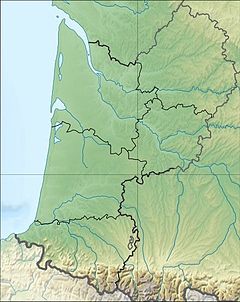La Ferrassie is an archaeological site in Savignac-de-Miremont, in the Dordogne department, France.[1] The site, located in the Vézère valley,[2] consists of a large and deep cave flanked by two rock shelters[3] within a limestone cliff, under which there is a scree slope formation.[1]
La Ferrassie | |
 La Ferrassie | |
| Location | near Savignac-de-Miremont |
|---|---|
| Region | Dordogne, France |
| Coordinates | 44°57′07″N 0°56′17″E / 44.95194°N 0.93806°E |


Age
editArtifacts found at the site are the productions of Mousterian (300,000-30,000 BP), Aurignacian (45,000–35,000 BP), and Périgordian (35,000–20,000 BP) cultures.[4] The cave area contains Gravettian (32,000–22,000 BP) objects and the scree contains objects from all these ages as well as the Châtelperronian (35,000-29,000 PB). The site was abandoned during the Gravettian period (27 kya).[3] Complex Mousterian burial structures found at La Ferrasie finally provided the evidence of Neanderthal burial practice.[5]
Exploration history
editA small area of the site was initially investigated by M. Tabanou in 1896,[3] a teacher who died of a landslide at the Badegoule rock shelter shortly thereafter.[6] Denis Peyrony and Louis Capitan explored the site in 1905, 1907 and 1912; Peyrony in 1934, Henri Delporte in 1969 and 1984, and Delporte with Tuffreau in 1984.[4][1]
Fossils
editAt least seven Neanderthals have been found in La Ferrassie, including infants and one[7] fetus. All specimens were found in a thin 60 cm archaeological layer dated to 74-68 thousand years ago.
| Name | Develop- mental age |
Notes |
|---|---|---|
| La Ferrassie 1 ♂ | 45 | The skeleton of an adult male, including the most complete Neanderthal skull ever found.[8][better source needed] Discovered in 1909.[3] |
| La Ferrassie 2 ♀ | 25–30 | An incomplete cranium and skeleton of a female Neanderthal found in 1910 and dated to 68-74,000 before present. This is now kept in the Musée de l'Homme.[3] |
| La Ferrassie 3 | 10 | A partial child skeleton.[9]: 30–31 [10] |
| La Ferrassie 4 | 8.5 months (fetal age)[9] |
The bones of a late-term fetus or of a newborn. Now thought to belong to Le Moustier 2.[7] |
| La Ferrassie 4bis | ~12 days[10]: 26 | A partial child skeleton.[9]: 30–31 [10] |
| La Ferrassie 5 | ~7 months (fetal age)[10] |
Fetus[9]: 38 [11] |
| La Ferrassie 6 | 3–5 | Nearly complete skeleton of a juvenile discovered in 1921.[3] |
| "La Ferrassie 7" | – | A talus bone named LF7 by Boule (1924), who thought despite its small size that it represented a third adult. Now thought part of La Ferrassie 3.[10]: 6 |
| La Ferrassie 8 | 22–26 months[9]: 41 | Young child with well-preserved teeth. |
Notes
edit- ^ a b c Peregrine & Ember 2001
- ^ Blades 1999, Abstract
- ^ a b c d e f Wood 2011
- ^ a b Blades 2009
- ^ Binford 1968
- ^ Peyrony 1934
- ^ a b B. Maureille (2002). "Anthropology: A lost Neanderthal neonate found". Nature. 419 (33–34): 33–4. Bibcode:2002Natur.419...33M. doi:10.1038/419033a. PMID 12214223. S2CID 4354501.
- ^ Smithsonian 2010
- ^ a b c d e J.-L. Heim (1976). Les Hommes Fossiles de la Ferrassie. Le gisement. Les squelettes adultes (crâne et squelette du tronc). Archives de l'Institut de Paléontologie Humaine. Vol. 1. Paris: Masson.
- ^ a b c d e J.-L. Heim (1982). Les enfants néandertaliens de La Ferrassie. Paris: Masson. ISBN 2-225-76351-8.
- ^ Balzeau and Radovčić (2008)
References
edit- Binford, SR (1968). "A Structural Comparison of Disposal of the Dead in the Mousterian and the Upper Paleolithic". Southwestern Journal of Anthropology. 24 (2): 139–154. doi:10.1086/soutjanth.24.2.3629419. JSTOR 3629419. S2CID 160261723.
- Blades, BS (July 1999). "Aurignacian lithic economy and early modern human mobility: new perspectives from classic sites in the Vézère valley of France". J Hum Evol. 37 (1): 91–120. doi:10.1006/jhev.1999.0303. PMID 10375477.
- Blades, BS (2009). "Aurignacian Core Reduction and Landscape Utilization at La Ferrasie, France". In Blades, BS; Adams, B (eds.). Lithic Materials and Paleolithic Societies. John Wiley & Sons. pp. 186–95. ISBN 9781444311969.
- Peregrine, PN; Ember, M, eds. (2001). Encyclopedia of Prehistory. Vol. 4: Europe. Kluwer Acad. ISBN 9780306462641.
- Peyrony, D (1934). La Ferrassie: Moustérien — Périgordien — Aurignacien (PDF) (in French). Reprinted by Kraus Reprint in 1976.
En 1896, j'y fus amené par Tabanou, ce malheureux instituteur qui devait un peu plus tard périr sous un éboulement dans ses recherches à Badegoule.
[dead link] - Quam, Rolf; Martínez, Ignacio; Arsuaga, Juan Luis (2011). "New Observations on the Human Fossils from Petit-Puymoyen (Charente)" (PDF). PaleoAnthropology. 2011: 102. doi:10.4207/PA.2011.ART44. ISSN 1545-0031.[dead link]
- "La Ferrassie". Smithsonian Institution's Human Origins Program. 2010. Retrieved 1 December 2012.
- Wood, B, ed. (2011). Wiley-Blackwell Encyclopedia of Human Evolution. John Wiley & Sons. ISBN 9781444342475.


